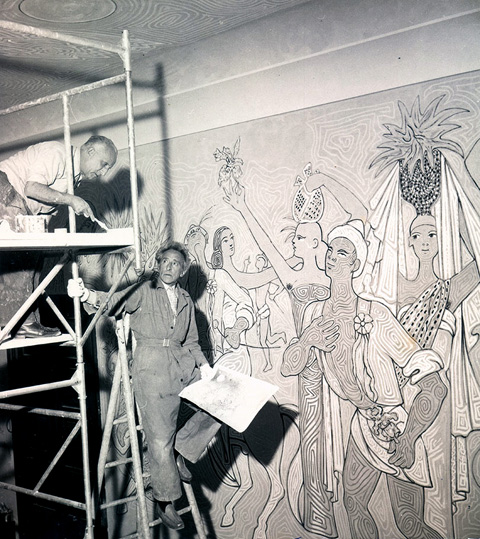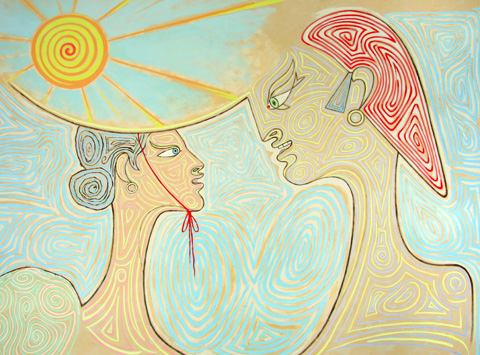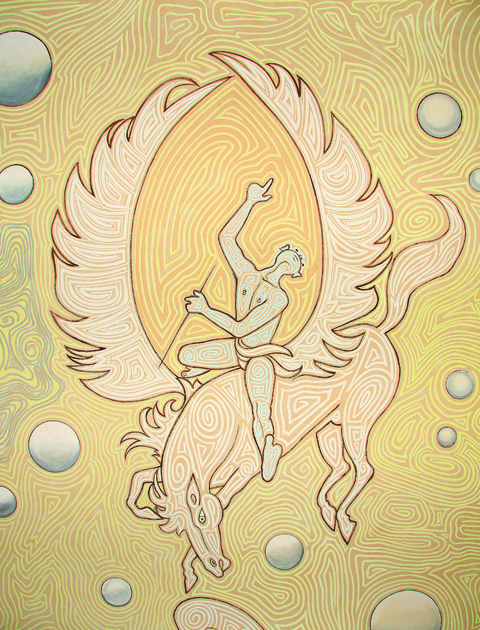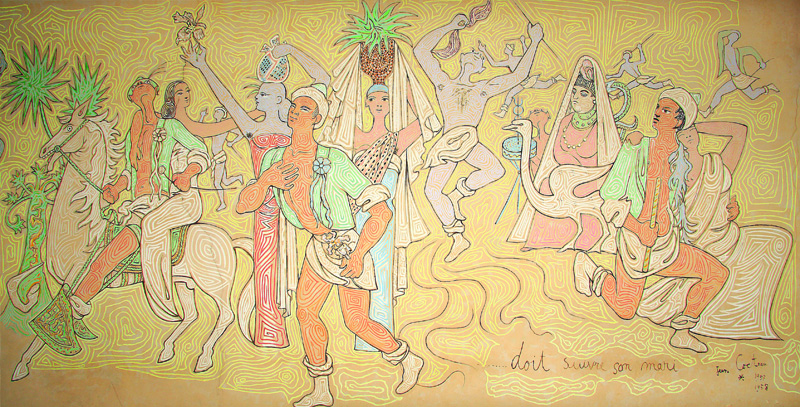Studies for the Menton wedding hall
The project
In 1955, the Menton town Council decided to redevelop its town hall, and in particular to transform the old courtroom into a wedding hall. On August 4 of that same year, Jean Cocteau discovered the town on the occasion of the Music Festival he had been invited to attend: shortly after this first contact, the mayor, Francis Palmero, showed Cocteau the hall and suggested entrusting the decoration to him.
Already engaged in another decoration project, that of the Saint-Pierre chapel in Villefranche-sur-Mer, Cocteau would begin work on the wedding hall in the spring of the following year. In a few days he “found” the motifs of the main compositions – a couple of lovers, the myth of Orpheus, an exotic wedding scene, an allegorical ceiling – but did not immediately decide on a particular graphic treatment for them. After obtaining the mayor’s approval, he had his designs enlarged and transferred to the walls with the help of a team of painters.
It was only then that the vision of a new graphic style imposed itself on him: to set these new decorations apart from those of the Villefranche chapel, Cocteau had the idea of dressing them with coloured lines winding in the shape of arabesques and spirals, filling all surfaces. He named this technique, invented specially for the wedding hall, “the Menton style”, and, trying to go back to the unconscious sources of his inspiration, detected the influence of the geometric decorations of the ancient palace of Knossos: “Knossos! It is the Minoan style and the splendour of the princes of Crete, it is the meandering lines of the labyrinth - that is what I had been looking for without finding it.”

The wedding hall was inaugurated by Jean Cocteau on March 22, 1958.
The studies
The preparatory drawings date for the most part from a period extending from April 1956 to August 1957. They make it possible to follow the progression of the “Menton style”, from the first somewhat erratic meanders towards a systematic method where the coloured lines wind around themselves like spirals while following the contours of the pattern.
In the wedding hall, the main wall – the one the bride and groom stand facing – represents a couple of lovers in profile, face to face; the young woman wearing a “capeline”, a large straw hat from Menton, and the young man wearing the typical hat of Mediterranean fishermen. Two sketches presented here show the evolution of the composition towards the form chosen by Cocteau.

Another set of drawings relate to the scene depicted on the right wall of the room, which represents a wedding imbued with exuberant orientalism. The characters represented - the newlywed couple on horseback, their cheering friends, the groom’s sullen mother and his former fiancée in tears - are quite close to the final forms chosen by Cocteau.
A study, entitled The Poets, reveals a first version of what became, after substantial modifications, the motif of the ceiling of the wedding hall. Pegasus however is already featured — a symbol of poetic inspiration and an allusion to the art Jean Cocteau had a predilection for.

External links :
Location of the wedding hall on Google Maps:
Virtual tour of the wedding hall on the website of the town of Menton
